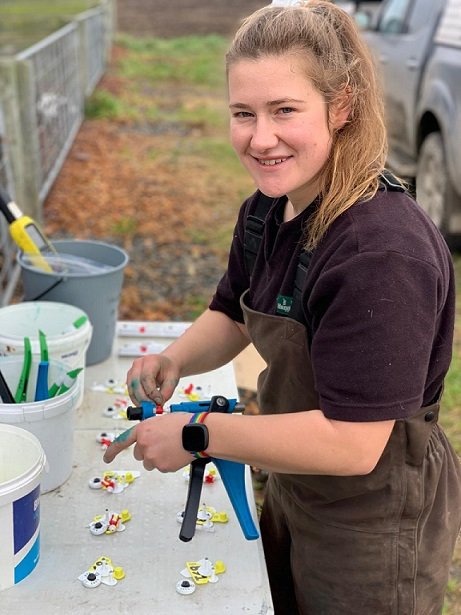Each calving season, Canterbury’s Rakaia Island group of farms use DNA verification to identify and match the parentage for thousands of calves born across its six dairy farm units.
Then, in spring, the farms use the parentage information to manage the genetic choices of more than 12,500 cows.
Courtney Churstain, Rakaia Island’s Business Improvement Analyst, describes in more detail how the GeneMark information is gathered and utilised.
“We use GeneMark (parentage) identification in combination with collars, which makes management of our animals efficient and reliable – the technology gives us a better insight into every individual cow… at the end of the day that’s why we’re farmers, because we love the animals, we want them to perform the best they can, and we want to treat them the way a small (scale) farmer would. We want to avoid managing them all the same with blanket approach.”

Courtney says Rakaia Island has used GeneMark’s parentage identification service for many years, dating back to before she started with the farming organisation five years ago.
“We use DNA because we have a large number of animals. Our calving spread is condensed, meaning we reach our heifer replacement numbers within 3-4 weeks.
"We have one specialised calf team that looks after all the new animals, so everything (calves from across all six farms) gets dropped at the one location for us, where the team feeds and manages the (young stock) growth.
"It would be very hard to manually match the parentage in terms of who-had-what out in the paddock, and even harder when they come in as one bulk lot. So, we use the service for ease of identification during calving.”
Rakaia Island also uses the GeneMark data to match its best heifers and cows to sexed semen and Premier Sires Forward Pack, as well as choosing the lower-end cows that are more appropriate to go to beef straws.
A spreadsheet is used that splits the organisation’s most-desirable genetics for replacement semen from the genetics that it doesn’t want replacements from, with Breeding Worth a key part of the criteria.
The process for collecting DNA samples is straight-forward, Courtney says.
“We tag the calves at 7 days old, and we take the (GeneMark) samples at the same time as the vets are doing de-budding, so the calves are asleep at the time which makes it really easy because they’re nice and still and the ears aren’t moving.”
Once parentage results are received, and the Rakaia Island farms have an accurate record of what’s on-the-ground, staff input weight results against the young replacements, with weights tracked until they become a dairy cow, Courtney says.
The rising one-year-olds (R1s) get their weights recorded monthly for 12 months, and as an R2 the stock gets weighed quarterly.
Why the emphasis on recording weights?
“It’s all about growing a good animal,” Courtney says. “While we might have great genetics, we know the formula P = G+E (phenotype equals genetics plus environment), and if you don’t have the environment right, that’s going to trump your genetics.
“It would be a real shame not to get the best out of the animals through something that’s under our influence, so it’s almost like a check on ourselves – to make sure we’re doing the best we can for them, and their growth rates are an integral part of that.”
Accurate parentage ensures calves are measured and monitored against their correct liveweight target, helping to improve oversight of the animal’s expected performance.
“Bringing them through the yard, we get a close-up look at them, and they get all their minerals and vaccines at the same time, so it all works in quite well.
“In summary I suppose the biggest advantage of GeneMark is that we have (close to) 100% ancestry, so the data we have is reliable and this makes for accurate decisions. When we have key focuses or objectives, we know the data we’re looking at is spot-on.
"For example, if we’re trying to improve our BW, obtaining accurate parentage information from GeneMark allows us to decide what our bottom-line is.”




